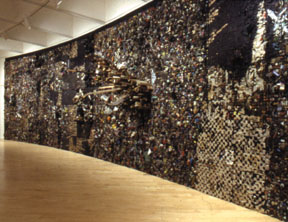|
Remembrance of Things Trashed
 |
By Caleb Mason
At the opening of his new exhibit, "Directions," at the Hirshorn Museum in Washington, Leonardo Drew was asked whether his work is political. He responded that his art should speak for itself. And it did a moment later. No sooner had the tide of questioners and admirers receded than a portly tourist couple, outfitted with fanny packs, guidebooks and cameras, poked their heads in to take a look at the exhibit. "It's just a bunch of trash stuck on the wall!" exclaimed the man, recoiling in disgust.
Drew's new wall-mounted sculptures - massive, heterogeneous, untitled - are occasions for reflection, cultural inkblots, hyperactive cousins of Rothko's black-on-black "Chapel" canvases: at once familiar and unsettling. They demand, and reward, patient and detailed examination. "Directions" consists of three large mosaics: panels constructed of small squares of plywood, each with a piece of junk or consumer detritus glued to it, joined together by the thousands to form vast agglomerations; the largest piece is 14 by 56 feet.
One is struck first by the diversity of objects comprising the mosaics: lightbulbs, dishes, bottles, computer cables, vacuum tubes, seat belt clips, assorted car parts, shoes, children's toys and dolls, circuit boards, a torn postcard of Jesus, a transistor radio, a football, an iron, a sewing machine (in pieces), a blow dryer, a baseball, rusted scrap metal, cassette tapes, a spiral notebook - the list could go on for pages. What the objects have in common is that they've all been discarded; Drew gets his materials from scrap yards, landfills and the street. They are the excrement of consumer culture, held up in public view to be gazed at, to be objects of respect, meditation, even desire. We never relinquish our fascination with feces, said Freud, we only sublimate it.
But one of the more surprising discoveries is how much of the junk has made it through the nation's intestinal tract intact: almost everything here is, if not usable, at least recyclable. These materials aren't available for art in the undeveloped world, Drew noted at the opening. Working on a similar project in Brazil, he found that "they use all this stuff. It's not junk, it's gold." This art is made possible by America's material wealth and prodigality, and the frantic imperatives of overproduction.
Caleb Mason teaches literature and philosophy at Columbia University and in the SUNY system.
![]()
|
In These Times ©
2000
Vol. 24, No. 12 |
